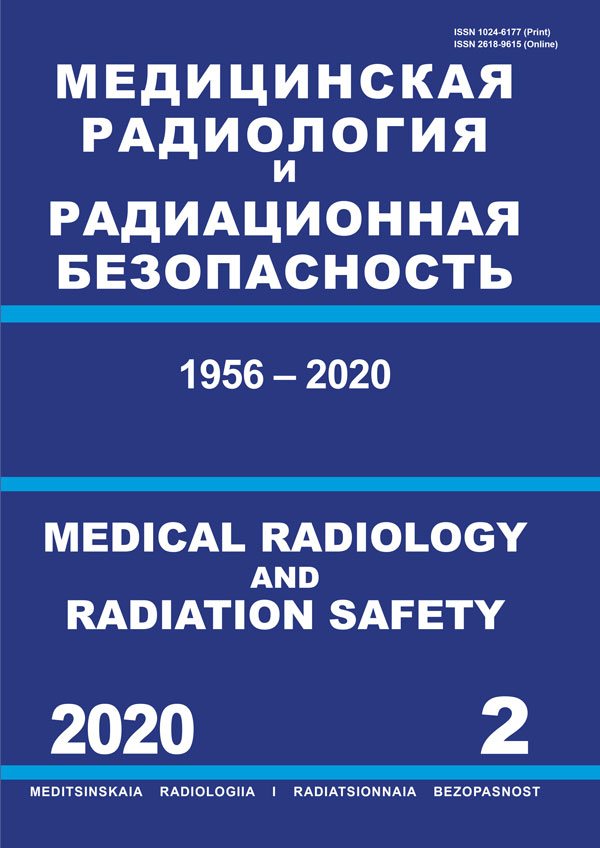Siberian State Medical University (Professor)
Cancer Research Institute, Tomsk National Research Medical Center, Russian Academy of Sciences (Junior Researcher)
Russian Federation
Siberian State Medical University (Professor)
Cancer Research Institute, Tomsk National Research Medical Center, Russian Academy of Sciences
National Research Tomsk State University
Siberian State Medical University (Associate Professor)
GRNTI 76.03 Медико-биологические дисциплины
GRNTI 76.33 Гигиена и эпидемиология
OKSO 14.04.02 Ядерные физика и технологии
OKSO 31.06.2001 Клиническая медицина
OKSO 31.08.08 Радиология
OKSO 32.08.12 Эпидемиология
BBK 51 Социальная гигиена и организация здравоохранения. Гигиена. Эпидемиология
BBK 534 Общая диагностика
TBK 5708 Гигиена и санитария. Эпидемиология. Медицинская экология
TBK 5712 Медицинская биология. Гистология
TBK 5734 Медицинская радиология и рентгенология
TBK 6212 Радиоактивные элементы и изотопы. Радиохимия
Purpose: Description of the collection, structure and development dynamics during the period from 2015 to 2019 of the biological material bank of the Seversk Biophysical Research Center, as well as research works carried out using biological material from its collection. Material and methods: The collection of bank of biological material includes the following types of biological material: venous blood, genomic DNA of white blood cells, cytogenetic suspensions of blood lymphocytes, surgical, biopsy and autopsy material. Biological material was obtained from people exposed to chronic radiation exposure: employees of the nuclear industry and the population permanently residing in the territory located in the area of the nuclear industry. Results: At present, the collection of the biological material bank contains more than 21,000 samples of biological material obtained from more than 8,000 donors. The collection of bank of biological material is represented by 4 main blocks: biological material of conditionally healthy employees of company of the nuclear industry (Siberian Chemical Combine); biological material of conditionally healthy people permanently residing in the territory located in the area of the nuclear industry enterprise (Seversk); biological material of patients (workers of the Siberian Chemical Combine and residents of Seversk) with malignant neoplasms and biological material of patients (workers of the Siberian Chemical Combine and residents of Seversk) with acute myocardial infarction. In the collection of bank of biological material, the proportion of samples of biological material of relatively healthy workers of the Siberian Chemical Combine is 33 %, residents of Seversk — 40.8 %, patients with malignant neoplasms — 22.2 %, patients with acute myocardial infarction — 4 %. Conclusion: Biological material bank Seversk Biophysical Research Center is unique collection of biological material samples of healthy people and patients with socially significant diseases. A feature of the biological material of the biological material bank is that it is obtained from people who have been exposed to chronic low-intensity radiation exposure and can be used to evaluate its radiogenic effects.
bank of biological material, ionizing radiation, chromosomal aberration, malignant neoplasms, acute myocardial infarction
1. Kornienko IV, Faleeva TG, Rakuts VS, Ivanov IN, Sidorenko YuS. The case for creating a national DNA repository of biological samples in the Russian Federation. Theory and Practice of Forensic Science. 2018;13(4):60-7. (in Russ.) DOI:https://doi.org/10.30764/1819-2785-2018-13-4-60-67.
2. Balanovska EV, Zhabagin MK, Agdzhoyan AT, et al. Population biobanks: principles of organization and prospects of application in genogeography and personalized medicine. Genetics. 2016;52(12):1371-87. (in Russ.). DOI:https://doi.org/10.7868/S001667581612002X.
3. Kodama Y, Mashima J, Kaminuma E, Gojobori T, Ogasawara O, Takagi T, et al. The DNA Data Bank of Japan launches a new resource, the DDBJ Omics Archive of functional genomics experiments. Nucleic Acids Res. 2012;(40):38-42. DOI:https://doi.org/10.1093/nar/gkr994.
4. Takhauov RM, Karpov AB, Albach EN, Khalyuzova MV, Freidin MB, Litviakov NV, et al. The bank of biological samples representing individuals exposed to long-term ionizing radiation at various doses. Biopreservation and Biobanking. 2015;13(2):72-8. DOI:https://doi.org/10.1089/bio.2014.0035.
5. Mezheritsky SA, Takhauov RM, Karpov AB, Litviakov NV, Vasilieva EO, Goncharik OO, et al. Healthy employees’ biological material bank at the Siberian group of chemical enterprises. Medicine of extreme situations. 2013;1(43):30-9. (in Russ.)
6. Litviakov NV, Freidin MB, Khalyuzova MV, Sazonov AS, Vasilyeva EO, Albach EN, et al. The frequency and spectrum of cytogenetic anomalies in employees of Siberian group of chemical enterprises. Radiation biology. Radioecology. 2014;54(3):283-96. (in Russ.). DOI:https://doi.org/10.7868/S0869803114030084.
7. Litviakov NV, Khalyuzova MV, Takhauov RM, Sazonov AS, Isubakova DS, Bronikovskaya EV, et al. DNA copy number variations of blood lymphocytes in people exposed to occupational irradiation as a possible marker of high radiosensitivity. Tomsk state university journal of biology. 2015;2(30):113-33. (in Russ.). DOI:https://doi.org/10.17223/19988591/30/8.
8. Khalyuzova MV, Litviakov NV, Takhauov RM, Isubakova DS, Usova TV, Bronikovskaya EV, et al. Delayed changes in the frequency of unstable chromosomal aberrations and the CNA-genetic landscape of blood leukocytes in people exposed to long-term occupational irradiation. Radiation biology. Radioecology. 2018;6:565-73. (in Russ.). DOI:https://doi.org/10.1134/S0869803118050090.
9. Litviakov NV, Goncharik OO, Freidin MB, Sazonov AE, Vasilyeva EO, Mezheritsky SA, et al. The estimate of association between gene polymorphisms and the frequency and spectrum of cytogenetic abnormalities in the cohort of Siberian group of chemical enterprises employees exposed to professional irradiation (microarray studies). Radiation biology. Radioecology. 2013;53(2):137-50. (in Russ.). DOI:https://doi.org/10.7868/S0869803113020069.
10. Khalyuzova MV, Litviakov NV, Isubakova DS, Bronikovskaya EV, Usova TV, Albach EN, et al. Validation of the association between gene polymorphism and frequency of cytogenetic abnormalities in the cohort of employees of radiation facilities. Radiation biology. Radioecology. 2017;57(4):365-83. (in Russ.). DOI:https://doi.org/10.7868/S0869803117040038.





